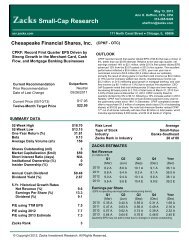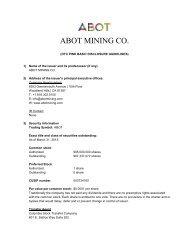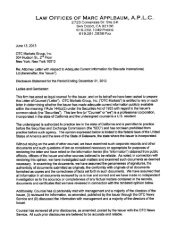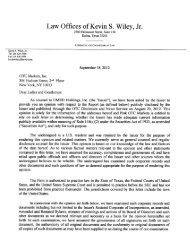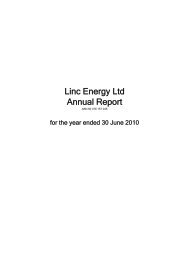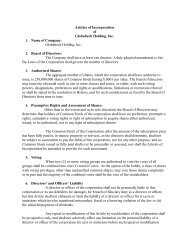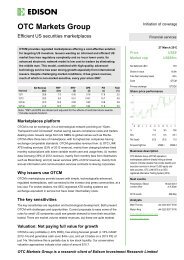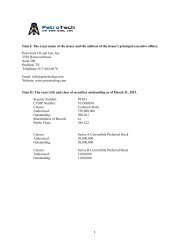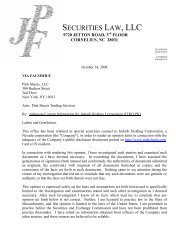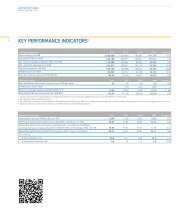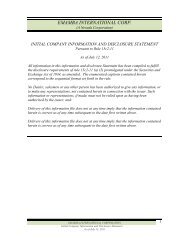2013 Apr 15 Annual Report 2012 - Phosphagenics
2013 Apr 15 Annual Report 2012 - Phosphagenics
2013 Apr 15 Annual Report 2012 - Phosphagenics
You also want an ePaper? Increase the reach of your titles
YUMPU automatically turns print PDFs into web optimized ePapers that Google loves.
Notes to the consolidated fi nancial statements<br />
2. SUMMARY OF SIGNIFICANT ACCOUNTING POLICIES (CONTINUED)<br />
The head entity, <strong>Phosphagenics</strong> Limited and the controlled entities in the tax consolidated group continue<br />
to account for their own current and deferred tax amounts. The Group has applied the Group allocation<br />
approach in determining the appropriate amount of current taxes and deferred taxes to allocate to<br />
members of the tax consolidated group.<br />
(i) Income Tax (continued)<br />
In addition to its own current and deferred tax amounts, <strong>Phosphagenics</strong> Limited also recognises<br />
the current tax liabilities (or assets) and the deferred tax assets arising from unused tax losses and unused<br />
tax credits assumed from controlled entities in the tax consolidated group.<br />
(j) Other taxes<br />
Revenues, expenses and assets are recognised net of the amount of GST except:<br />
• where the GST incurred on a purchase of goods and services is not recoverable from the taxation<br />
authority, in which case the GST is recognised as part of the cost of acquisition of the asset or as part<br />
of the expense item as applicable; and<br />
• receivables and payables are stated with the amount of GST included.<br />
The net amount of GST recoverable from, or payable to, the taxation authority is included as part of<br />
receivables or payables in the statement of fi nancial position.<br />
Cash fl ows are included in the statement of cash fl ows on a gross basis and the GST component of cash<br />
fl ows arising from investing and fi nancing activities, which is recoverable from, or payable to, the taxation<br />
authority is classifi ed as part of operating cash fl ows. Commitments and contingencies are disclosed<br />
net of the amount of GST recoverable from, or payable to, the taxation authority.<br />
81<br />
(k) Intangible assets<br />
Intangible assets acquired separately or in a business combination are initially measured at cost. The cost<br />
of an intangible asset acquired in a business combination is its fair value as at the date of acquisition.<br />
Following initial recognition, intangible assets are carried at cost less any accumulated amortisation<br />
and any accumulated impairment losses. Internally generated intangible assets, excluding capitalised<br />
development costs, are not capitalised and expenditure is recognised in the statement of comprehensive<br />
income in the year in which the expenditure was incurred.<br />
The useful lives of intangible assets are assessed to be either fi nite or indefi nite. Intangible assets with fi nite lives<br />
are amortised over the useful life and tested for impairment whenever there is an indication that the intangible<br />
asset may be impaired. The amortisation period and the amortisation method for an intangible asset with a fi nite<br />
useful life is reviewed at least at each fi nancial year end. Changes in the expected useful life or the expected<br />
pattern of consumption of future economic benefi ts embodied in the asset are accounted for prospectively<br />
by changing the amortisation period or method, as appropriate, which is a change in accounting estimate.<br />
The amortisation expense on intangible assets with fi nite lives is recognised in the statement of comprehensive<br />
income in the expense category consistent with the function of the intangible asset.<br />
Intangible assets with indefi nite useful lives are tested for impairment annually either individually or at<br />
the cashgenerating unit level. Such intangibles are not amortised. The useful life of an intangible asset<br />
with an indefi nite life is reviewed each reporting period to determine whether indefi nite life assessment<br />
continues to be supportable. If not, the change in the useful life assessment from indefi nite to fi nite is<br />
accounted for as a change in an accounting estimate and is thus accounted for on a prospective basis.<br />
Research and Development costs<br />
Research costs are expensed as incurred. An intangible asset arising from development expenditure on an<br />
internal project is recognised only when <strong>Phosphagenics</strong> can demonstrate the technical feasibility of completing<br />
the intangible asset so that it will be available for use or sale, its intention to complete and its ability to use or<br />
sell the asset, how the asset will generate future economic benefi ts, the availability of resources to complete<br />
the development and the ability to measure reliably the expenditure attributable to the intangible asset during<br />
its development. Following the initial recognition of the development expenditure, the cost model is applied<br />
requiring the asset to be carried at cost less any accumulated amortisation and accumulated impairment<br />
losses. Any expenditure so capitalised is amortised over the period of expected benefi t from the related project.<br />
NOTES TO THE CONSOLIDATED FINANCIAL STATEMENTS



